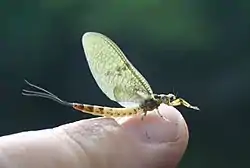蜉蝣
Chinese
| Ephemera strigata | |||
|---|---|---|---|
| simp. and trad. (蜉蝣) |
蜉 | 蝣 | |
| alternative forms | 浮游 | ||
Etymology
(This etymology is missing or incomplete. Please add to it, or discuss it at the Etymology scriptorium. Particularly: “looks like there's some sort of reduplication”)
Pronunciation
Noun
蜉蝣
- mayfly
- 蜉蝣之羽、衣裳楚楚。 [Pre-Classical Chinese, trad. and simp.]
- From: The Classic of Poetry, c. 11th – 7th centuries BCE, translated based on James Legge's version
- Fúyóu zhī yǔ, yīshang chǔchǔ. [Pinyin]
- The wings of the ephemera, are robes, bright and splendid.
Derived terms
|
Descendants
Japanese

Etymology 1
| Kanji in this term | |
|---|---|
| 蜉 | 蝣 |
| かげろう | |
| Hyōgaiji | Hyōgaiji |
| jukujikun | |
| Alternative spelling |
|---|
| 蜻蛉 (obsolete) |
Change in meaning from 陽炎 (kagerō, “heat haze, heat shimmer”), from the way that the insects fly in swarms that visually resemble heat haze.[1] The kanji is jukujikun (熟字訓), from Chinese 蜉蝣 (fúyóu).
Pronunciation
Usage notes
As with many terms that name organisms, this term is often spelled in katakana, especially in biological contexts (where katakana is customary), as カゲロウ.
Etymology 2
| Kanji in this term | |
|---|---|
| 蜉 | 蝣 |
| Hyōgaiji | Hyōgaiji |
| irregular | |
Change in meaning from 陽炎 (kagirō, “heat haze, heat shimmer”), from the way that the insects fly in swarms that visually resemble heat haze.[1]
Obsolete reading.
Etymology 3
| Kanji in this term | |
|---|---|
| 蜉 | 蝣 |
| ふ Hyōgaiji |
ゆう Hyōgaiji |
| on’yomi | |
From Middle Chinese 蜉蝣 (bjuw yuw?). Compare Mandarin 蜉蝣 (fúyóu), Vietnamese phù du.
Pronunciation
Noun
- a mayfly
- (by extension) ephemerality (from the way that mayflies are born and die within a day)